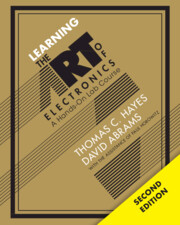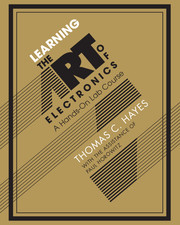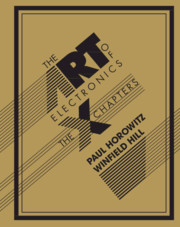Learning the Art of Electronics
The much-anticipated new edition of 'Learning the Art of Electronics' is here! It defines a hands-on course, inviting the reader to try out the many circuits that it describes. Several new labs (on amplifiers and automatic gain control) have been added to the analog part of the book, which also sees an expanded treatment of meters. Many labs now have online supplements. The digital sections have been rebuilt. An FPGA replaces the less-capable programmable logic devices, and a powerful ARM microcontroller replaces the 8051 previously used. The new microcontroller allows for more complex programming (in C) and more sophisticated applications, including a lunar lander, a voice recorder, and a lullaby jukebox. A new section explores using an Integrated Development Environment to compile, download, and debug programs. Substantial new lab exercises, and their associated teaching material, have been added, including a project reflecting this edition's greater emphasis on programmable logic. Online resources including online chapters, teaching materials and video demonstrations can be found at: https://LearningTheArtOfElectronics.com.
- Teaches electronics in day-at-a-time practical doses so that students can learn in a hands-on way
- The integration of discussion of design with a chance to try the circuits means students learn quickly
- Accompanied by a companion web site LAoE.link that redirects the printed links in the book to the actual Internet reference
- Additional online chapters cover breadboarding hints & tips, alternatives to the microcontroller and FPGA, creating Verilog test benches, and up-to-date lists of equipment and sources for parts
- Provides a complete introduction to embedded programming, beginning with blinking an LED and ending with a complex application using a Real Time Operating System (RTOS)
- Offers a simple, device-agnostic introduction to programmable devices using an online development system that runs in a browser
Reviews & endorsements
‘The University of Maryland physics department has been using Learning the Art of Electronics for several years now as the basis for a course for senior undergraduates / young graduate students in order to give them the tools they need to be successful in experimental research. The course also serves a wide variety of Ph.D. candidates in our engineering college. The text, with its laboratory exercises, not only introduces them to the fundamentals of experiment readout and a wide variety of circuits and techniques, but methodically introduces them to the common mistakes and oversimplifications typical of new designers. I was thrilled to see this new edition contains an entirely new set of chapters introducing students to professional-level use of a microcontroller development environment and real-time operating systems, that goes far beyond the very simple exercises typically found on public web sites and other resources. We used preliminary versions of these exercises in our spring 2024 lab course, and the students were immediately able to use what they learned in their own research.’ Sarah C. Eno, University of Maryland, College Park
Product details
April 2025Paperback
9781009535182
1180 pages
253 × 203 × 42 mm
2.33kg
Available
Table of Contents
- Preface to the second edition
- Preface to the first edition
- Overview, as the course begins
- Part I. Analog: Passive Devices:
- 1. DC circuits
- 2. RC circuits
- 3. Diode circuits
- Part II. Analog: Discrete Transistors:
- 4. Transistors I
- 5. Transistors II
- Part III. Analog: Operational Amplifiers and their Applications:
- 6. Op-Amps I
- 7. Op-Amps II: Departures from ideal
- 8. Op-Amps III: Nice positive feedback
- 9. Op-Amps IV: Parasitic oscillations
- active filter
- 10, Op-Amps V: PID motor control loop and lock-in amplifier
- 11. Voltage regulators
- 12. MOSFET switches and an introduction to JFETs
- 13. Group audio project
- Part IV. Digital: Gates, Flip-Flops, Counters, PLD, Memory:
- 14. Logic gates
- 15. Introduction to programmable logic
- 16. Flip-Flops
- 17. Counters
- 18. Memory
- 19. Finite state machines
- Part V. Digital: Analog–digital, PLL, Digital project lab:
- 20. Analog ↔ digital
- PLL
- 21. Digital project lab
- Part VI. Microcontrollers:
- 22. Microcontrollers I: Introduction
- 23. Microcontrollers II: Stacks, timers and input
- 24. Microcontrollers III: Using internal peripherals
- 25. Microcontrollers IV: Timers & interrupts
- 26. Microcontrollers V: Serial communication
- 27. Microcontrollers VI: Using an RTOS
- 28. Project possibilities: toys in the attic
- A. Debugging circuits
- B. Pinouts
- C. Transmission lines
- D. Scope advice
- O. Online appendices
- Index.




